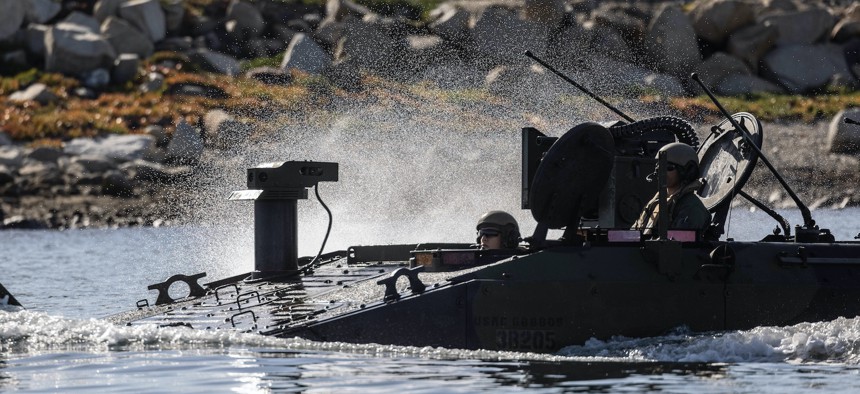
U.S. Marines with 3rd Assault Amphibian Battalion, 1st Marine Division, operate an Amphibious Combat Vehicle during a certification exercise at Marine Corps Base Camp Pendleton, California, Feb. 2, 2023. U.S. Marine Corps / Cpl. Cameron Hermanet
After 2 Rollovers, Marines Overhaul Amphibious Combat Vehicle Training
A brand-new unit will teach Marines to drive the vehicles through the surf.
The Marine Corps has created a new training unit for its Amphibious Combat Vehicle after two rollovers revealed that Marines needed more instruction on the new vehicle.
“The decision to stand up the [Transition Training Unit] came after the Marine Corps identified significant differences between the safe operating procedures of the ACV and its predecessor, the Assault Amphibious Vehicle,” the Marine Corps said in a press release provided to Defense One. “Preliminary findings from recent mishap investigations recommended that ACV operators receive more training focused on the internal mechanical systems of the ACV and how the platform differs from the AAV.”
The Marine Corps stopped ACV waterborne operations in the surf zone after two of the vehicles rolled over last year, one in July and another in October. That ban is still in effect, and the command investigations into the two accidents are in the “redaction process,” according to the release. The ACV is a replacement for the 70s-era AAV, which the service removed from deployment and water operations in December 2021 after a fatal sinking in California.
Gen. Eric Smith, the assistant commandant of the Marine Corps, acknowledged the ACV program’s rocky start in his written testimony for a hearing before the Senate Armed Services Readiness subcommittee Wednesday, and explained the training unit’s role to get them safely operating again.
“As with any new system, our ACVs have experienced some initial fielding challenges. We are working with our industry partners to address identified mechanical issues as we continue fielding and testing the new platform. We have also experienced training mishaps with four vehicles in the surf zone,” Smith wrote. “After several months of dedicated efforts, and the institution of a Transition Training Unit in our Amphibious Assault School, we have a phased plan that will allow our ACV operators to employ the vehicle safely and effectively.”
The ACV is used in Marine operations to travel from an amphibious warship to shore, over land, and back again. The personnel variant can hold three crew members and 13 Marines, according to a Congressional Research Service report.
But while the ACV and AAV perform the same mission, the platforms are “fundamentally dissimilar from one another,” Marine Corps spokesman Capt. Ryan Bruce said in an email Wednesday to Defense One. The AAV is a tracked vehicle with a flat-bottomed hull and an analog system, while the new ACV is a heavier, wheeled vehicle with a V-Shaped hull and digital system, Bruce said. The steering and propeller systems are also different.
“Because of these differences in their design, the vehicles behave differently in the surf zone,” he said.
The new training unit, which stood up in February, is part of the Assault Amphibian School at Camp Pendleton, Calif., and is basing the training on “lessons learned and best practices” and turning it “into an updated, continuous skills validation program,” the release said. The unit is the size of a platoon, or around 30 Marines. The program will eventually be rolled into the school’s regular training for the vehicle.
The Marine Corps has 139 ACVs fielded so far, with I Marine Expeditionary Force and the Assault Amphibian School as the priority for the platform, according to the release. Once the unit’s program is approved, Marines who are trained on the ACV will be evaluated and recertified on the vehicle. The certification course is expected to take less than a month, Bruce said.
The certification program has several stages, starting with a classroom element and then moving to the motor pool to “conduct highly controlled practical evaluations,” Bruce said. The Marines then do ground training, and finish with “waterborne practical evaluations,” he said.
“A critical component of the revised training program is the continuous training and evaluation of ACV Marines, with skills progression benchmarks that evaluate Marines on their knowledge of both operating and maintaining the vehicle and their ability to then apply that knowledge to real world operations,” he said. “This update supersedes previous training requirements, which were focused on a one-time certification of entry-level skills before a Marine could join their operational unit.”
It’s not clear how long retraining everyone will take, but Marines who haven’t yet been recertified are still able to operate the ACVs, Bruce said.
Getting Marines operating in the surf zone again will be a crawl-walk-run approach, starting with authorizing the new training unit to do transits through that environment and confirming their certification course, according to the release. From there, Marines in the certification program will be allowed to do transits, and eventually Marines will be allowed to travel again in an ACV through the zone. The process will start this summer.
The service is also using drone technology to address the hazardous conditions in the surf zone. Drones can collect data that will help Marines decide whether to proceed through the surf, Lt. Gen. Karsten Heckl, the head of Marine Combat Development Command, told senators March 28. Marines at Camp Pendleton already have the unnamed autonomous drone.
“We just got to work out these problems and make sure when we make a decision to go or no go through a surf zone, whether coming ashore or going back to the ship, that we have the right and accurate information to make that judgment,” Heckl said before the Senate Armed Services Seapower subcommittee.




